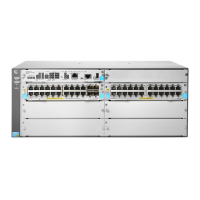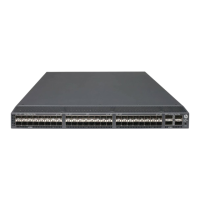100
[DeviceA-Ten-GigabitEthernet1/0/1] smart-link flush enable control-vlan 10 20
[DeviceA-Ten-GigabitEthernet1/0/1] quit
[DeviceA] interface ten-gigabitethernet 1/0/2
[DeviceA-Ten-GigabitEthernet1/0/2] port link-type trunk
[DeviceA-Ten-GigabitEthernet1/0/2] port trunk permit vlan 1 to 30
[DeviceA-Ten-GigabitEthernet1/0/2] smart-link flush enable control-vlan 10 20
[DeviceA-Ten-GigabitEthernet1/0/2] quit
Verifying the configuration
Use the display smart-link group command to display the smart link group configuration on a
device.
# Display the smart link group configuration on Device C.
[DeviceC] display smart-link group 1
Smart link group 1 information:
Device ID : 000f-e23d-5af0
Preemption mode : NONE
Preemption delay: 1(s)
Control VLAN : 10
Protected VLAN : Reference Instance 1
Member Role State Flush-count Last-flush-time
-----------------------------------------------------------------------------
XGE1/0/1 PRIMARY ACTIVE 5 16:45:20 2014/04/21
XGE1/0/2 SECONDARY STANDBY 1 16:37:20 2014/04/21
Use the display smart-link flush command to display the flush messages received on a device.
# Display the flush messages received on Device B.
[DeviceB] display smart-link flush
Received flush packets : 5
Receiving interface of the last flush packet : Ten-GigabitEthernet1/0/3
Receiving time of the last flush packet : 16:50:21 2014/04/21
Device ID of the last flush packet : 000f-e23d-5af0
Control VLAN of the last flush packet : 10
Multiple smart link groups load sharing configuration example
Network requirements
As shown in Figure 25:
• Device C is a Smart Link device. Device A, Device B, and Device D are associated devices.
Traffic of VLANs 1 through 200 on Device C is dually uplinked to Device A by Device B and
Device D.
• Implement dual uplink backup and load sharing on Device C: Traffic of VLANs 1 through 100 is
uplinked to Device A by Device B. Traffic of VLANs 101 through 200 is uplinked to Device A by
Device D.

